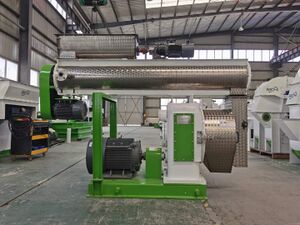Knowledge fuels change - Support energypedia!
For over 10 years, energypedia has been connecting energy experts around the world — helping them share knowledge, learn from each other, and accelerate the global energy transition.
Today, we ask for your support to keep this platform free and accessible to all.
Even a small contribution makes a big difference! If just 10–20% of our 60,000+ monthly visitors donated the equivalent of a cup of coffee — €5 — Energypedia would be fully funded for a whole year.
Is the knowledge you’ve gained through Energypedia this year worth €5 or more?
Your donation keeps the platform running, helps us create new knowledge products, and contributes directly to achieving SDG 7.
Thank you for your support, your donation, big or small, truly matters!
Pellet mill
Pellet mill is a specialized machine used in the biomass and animal feed industries to transform raw materials into compact pellets, which can serve various purposes ranging from fuel to animal feed[1]. This mechanical device has gained prominence due to its role in sustainable energy production and efficient feed processing. Pellet mills have evolved over time, incorporating advanced technologies to enhance their performance and versatility.
Overview
A pellet mill operates by compressing raw materials such as wood, agricultural residues, and feedstock into dense pellets through a process known as pelleting. These pellets possess uniform shape, size, and density, making them easier to handle, transport, and store. Pelleting not only reduces the volume of the original materials but also improves their handling characteristics and combustion efficiency[2].
Operation
The process within a pellet mill involves several key steps:
Preparation of Raw Materials: Raw materials, which can include wood chips, sawdust, crop residues, and feed ingredients, undergo preprocessing to achieve the desired particle size and moisture content. This preparation ensures consistent pellet quality.
Feeding and Conditioning: The preprocessed material is fed into the pellet mill's chamber, where it is conditioned by adding steam or water. Conditioning softens the material and improves its binding properties, aiding in pellet formation.
Pelletization: Within the pellet mill, the conditioned material is subjected to high pressure and temperature. This combination of mechanical force and heat causes lignin, a natural binder present in biomass, to soften and bind the particles together, forming pellets.
Cooling and Sizing: The freshly formed pellets are often hot and soft. They are conveyed to a cooling chamber, where ambient air cools them and reduces their moisture content. Subsequently, the pellets are screened to remove fines and ensure uniform size.
Packaging and Storage: The cooled and sized pellets are ready for packaging. Depending on their intended use, pellets can be used directly or stored in appropriate facilities for future use.
Types of Pellet Mills
Pellet mills come in various designs and sizes, catering to different applications. Common types include:
Flat Die Pellet Mills: Typically used for small-scale production and residential applications, these machines have a flat die and are suitable for producing animal feed and small quantities of biomass pellets.
Ring Die Pellet Mills[3]: Designed for larger-scale production, ring die pellet mills feature a rotating die with multiple rollers. They are more energy-efficient and can handle a wider range of raw materials.
Vertical Pellet Mills: These mills have a vertically oriented die and are often used for producing wood pellets. They offer advantages such as ease of maintenance and reduced wear.
Applications
Pellet mills have found applications in various sectors:
Renewable Energy: Wood pellets produced by pellet mills serve as a renewable energy source, used for residential heating, power generation, and industrial processes. Their consistent size and energy content make them a reliable substitute for fossil fuels.
Animal Feed: Pellet mills are crucial in the animal feed industry, as they process feed ingredients into pellets that are easier for animals to consume and digest. This enhances nutritional intake and feed efficiency.
Waste Management: Pelletizing agricultural and forestry residues helps in waste reduction and creates value-added products from materials that would otherwise be discarded.
Environmental Impact
The use of pellet mills for producing biomass pellets contributes to sustainable energy production, as the carbon emissions from burning pellets are offset by the carbon dioxide absorbed during plant growth. However, environmental considerations also include the sustainability of raw material sourcing and potential land use conflicts[4].
Future Trends
Advancements in pellet mill technology continue to improve efficiency, pellet quality, and versatility. Innovations such as automation, digital controls, and improved die designs are expected to shape the future of pellet mills, enabling greater precision and adaptability to diverse feedstocks.
In conclusion, the pellet mill stands as a crucial tool in the realms of biomass energy production and animal feed processing. Its role in transforming raw materials into valuable pellets underscores its significance in sustainable resource utilization and the pursuit of greener alternatives.
- ↑ The chemistry and technology of cereals as food and feed.
- ↑ Pietsch, Wolfgang (2005), Agglomeration in Industry: Occurrence and Applications, vol. 1, Wiley-VCH, p. 254, ISBN 978-3-527-30582-7.
- ↑ Introduction and Application of ring die Pellet Mill.
- ↑ Connecticut Agricultural Experiment Station (1898), Tenth Annual Report of the Storrs Agricultural Experiment Station, Storrs, Conn. 1897, Pelton & King, pp. 208–209.




















